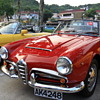Posted 11 years ago
 rniederman
rniederman
(350 items)
Here is an example of early glassware for collodion photographic chemistry. (About two years earlier I posted a ribbed Phenix collodion bottle.) In the early days of photography, photographers had to prepare their own negative emulsion chemistry. Before dry plates, a compound called collodion was used and it was pretty nasty stuff. (Cotton soaked in a nitric and sulfuric solution and then washed.)
Eventually, companies such as Anthony sold prepared chemistry. You carefully coated a glass plate before taking the picture. Actually, the picture had to be taken and developed while the collodion goo was still wet. That’s what is meant by ‘wet plate’ photography or cameras.
Original collodion photographic bottles are very rare, and shown here is a near mint condition bottle with "E. Anthony New York" moulded into the glass. The bottle came with its original paper label but given how fragile it is, a high quality copy replacement was made. I keep the original Anthony label safely stored.

























Link to the Phenix collodion bottle: http://www.collectorsweekly.com/stories/66539-early-glassware-container-for-collodion
I've wondered what a "wet plate" was & can now die a happy man. I really have wondered.
Thanks, geo26e!
Thanks, blunderbuss2! And glad you found this informational.
Thanks, f64imager!
Bottle looks 1890's. Is the bottle a tooled lip or applied lip ? To be 1860's it should have his 501 Broadway address. Would love to see pics of the other paper work. Nice bottle. I collect these Anthony's and have some nice ones.
Hi roaddog, thanks for stopping by and the comment. I don’t know much about bottles but as background the collodion process pretty much ended in the early 1890s when dry plates took over the industry. Yet collodion continued to be manufactured well into the 1890s as a niche product. It is true that Anthony made flint varnish that was sold in a bottle moulded with the 501 Broadway address. 1868 print advertising also notes this address and mentions E. & H.T. Anthony as the manufacturers (more on this in a bit).
From a photo-historical point of view, company information (superficially) points to 1860s. Granted, it’s not always 100% accurate but pretty reliable based on advertising ephemera. I thought carefully about dating the bottle and settled on the 1860s because of the company name on the label and bottle. To give a little background ... according to Henry Dietrich, a former Anthony employee who started working at 501 Broadway in September 1860, the name of the company at the time was E. Anthony. (They moved to 591 Broadway from 501 on February 10, 1869.) Dietrich comments about the declaration of war in 1861 and then taking a 3-year leave of absence in service with the army. When he came back, Henry Anthony was a partner and the company name changed to E. & H.T. Anthony. The change occurred sometime in 1862.
This bottle of collodion only notes the usual “None Genuine unless signed E. Anthony” text on the label and “E. Anthony New York” moulded into the bottle. FWIW, Anthony was very good at updating their products and print advertising with changes in their company name and street address. In regards to the product specifically, it was advertised a fair amount in the 1870s; and I have an 1899 Anthony catalogue listing of collodion products by the pound (as opposed to liquid). Unfortunately I haven’t seen good examples of how the product’s label and bottling might have changed over the years as the company evolved. For instance, Anthony’s later chemical bottles had their “EA” logo on the label.
Although it is possible that this could be a later bottle, my opinion is that Anthony would have changed the name in the glass to reflect the company’s current name and/or address, added the EA logo and so forth. For example, when Anthony opened an office in Chicago (~1901 or so), camera labels immediately included that city. Maybe this is a transition bottle when the company was in the process of moving to 591 Broadway ... I don’t really know.
I would definitely be interested in any information you have ... and of course ... you are now obligated to post onto CW’s Show & Tell your bottle collection! (Of course start with the Anthony bottles.) Question, do you have one of Anthony’s improved collodion vials?
Thanks. - Rob
Nice write up. In my expererience the 1850-1880 collocians were all aqua glass. I have a labeled clear one tooled lip, same mold as yours with a label and is from their 591 address. have not seen the EA show up in the molds. The EA only seems to show on the labels. I've done alot of research on Anthony. Have all his adresses from 1842-1902. Have a couple of the early pontils of mine on this site
http://www.luminous-lint.com/app/photographer/Edward__Anthony/C/
You have a nice collection. I especially like the really early bottles from 308 Broadway. When mentioning the “EA” logo (actually a trademark), I didn’t mean to imply it would appear in the glass but was noting that the trademark was an example of how Anthony was insistent in updating their materials with each successive company name and marketing change. And agreed; I’ve only seen the trademark on the label as well.
Based on Anthony’s advertising, "EA" appears to have come into use around 1868; just about a year before moving to 591 Broadway. As such, for a brief 1-year period (or so), you could have a late 1860s lens, paper, chemistry (etc) item with EA, E. & H.T. Anthony, and 501 Broadway markings. As such, I use 1868 (+/- a year or so) as the transition period from early Anthony advertising to their popular EA years. Again, not 100% perfect but a really good guideline for dating Anthony materials when taking into consideration the addresses.
In looking at the “Bottle for Anthony's Aristotype Toning and Fixing Solution” (1880 ca) posted on the Luminous Lint website, the inclusion of the EA logo (+/- 1868) and the fact that Anthony didn’t get involved with Aristotype chemistry until the 1890s, the address would most likely be 591 Broadway; especially given the company moved from their 501 address in 1869.
And reviewing this informative thread, I updated the posting title to include “attributed” in reference to the date.
Again, thanks for the reply and your insights.
Thanks, I glad to meet someone else into these type bottles. Kind of a specialized area. I mostly collect pontil meds. I'd love to see some pics of the paperwork you have with your bottle. It's true the labels often do not date the same as the bottles. This happens often in medicines as well.
I just added an image of the original label. Maybe you have some thoughts about it. Thanks.
Thanks, GTBOI!
Did Eastman Kodak ever have these kinds of bottles?
Have not seen that label. Of course I haven't seen the collodian label. The Varnish, Developer etc appear to have had different labels. Which kinda made sense since the same bottle was being used for different chemicals. Pretty sure yours is a tooled lip. They started this type of lip in 1884 I believe. Probably as in a lot of old meds. The very earlier ones the labels had the actual signature not a printed one as in the later bottles. Would love to get my hands on one of those.
Eastman Kodak did have some bottles. Tooled lip embossed 1890 ish ones.
I’ve been told this particular label is somewhat obscure. The E. Anthony signature is definitely printed and, as you can see, the original paper is very fragile. It was fortunate it came off the bottle in nearly one piece to create a decent reproduction.
I wasn't familiar with tooled vs. applied bottle lips so Google helped out. Unless I'm interpreting the info incorrectly, it appears bottles after 1860 and before 1880 have mold seams that stop under the lip (source: Antique Trader Bottles Identification and Price Guide Sixth Edition, Michael Polak). It was also pointed out that the lower the seam ending point, the earlier the bottle. In particular:
“The closer to the top of the bottle the seam extends, the more recent the bottle. On the earliest bottles manufactured before 1860, the mold seams will end low on the neck or at the shoulder. On bottles made between 1860 and 1880, the mold seam stops right below the mouth and makes it easy to detect that the lip was separately formed. Around 1880, the closed mold began to be used. With the closed mold, the neck and lip were mechanically shaped.”
I don't know if this is a hard-and-fast rule or merely a guideline, but unquestionably interesting. My Anthony bottle's seam definitely stops at the juncture where the body and neck meet. In other words, the neck and lip do not have a seam and this appears to match the definition of an earlier bottle. (Again, if I understand this correctly.) Amazing nuances in dating something as outwardly simple as a bottle. There’s always something new to learn!
Sean ... thanks for the 'love.' George Eastman's first company was "The Eastman Dry Plate and Film Company." The name of the firm pretty much sums up that they didn't get involved with collodion in a major way. Oddly however, my 1888 Eastman catalogue does include a listing for plain collodion to use for varnishing American films. And as roaddog points out, there were many bottles that held Eastman chemicals. Kodak chemical bottles and earthenware jugs appeared from the 1890s into the mid-1900s.
Thankyou Rob!! for the information , it would be very cool to see something like that in person.
The applied lip is where a separate piece of glass was applied to the neck. You can see the division and there is usually drips and glops of glass in that area. You can also feel the ledge inside the neck where the lip and neck were joined. The tooled lip is where the lip and neck are all one piece of glass and a special shaped tool was used to form the lip shape. Much smoother process with no crudeness. Mold line terminations aren't really good for determining age.
Thanks, roaddog ... great info.
I added some pics to show comparison in the Show and Tell section.
To anyone who is following this thread, here is roaddog's posting - terrific examples of photographic bottles: http://www.collectorsweekly.com/stories/133952-e-anthony?in=activity
roaddog ... I updated the title of this post to consider 1880s (attributed). You've been very helpful and I have more thinking to do about the product itself.
Thanks, David!
Thanks, Manikin!
Thanks, Jewels!
Thanks, aghcollect!
Thanks, vetraio50!
Thanks John, pops52, f64imager, and kerry10456!
I can't believe what prices these Anthony bottles are going for lately. Almost makes me want to sell...................Not. LOL
Hi roaddog ... where are prices now?
I recently saw a plain one like yours with no label sell for 70 bucks. I saw a labeled pontilled bottle go for near 800 bucks. These were the 8 ounce size. I saw an amber cylinder sell for near 150 bucks. One like yours it would be hard to say. Definitely in the hundreds. Seems like the last 6 months or so these things have taken off in price.
I guess these have really gone up in value. Thanks for the info, roaddog.
Thanks, PhotoGuy!
Thanks, Vermont!
Thanks, kaputs11!
Thanks!
motorheadmn
Nicefice
Thanks, Cisum!
Thanks!
RichmondLori
Vynil33rpm